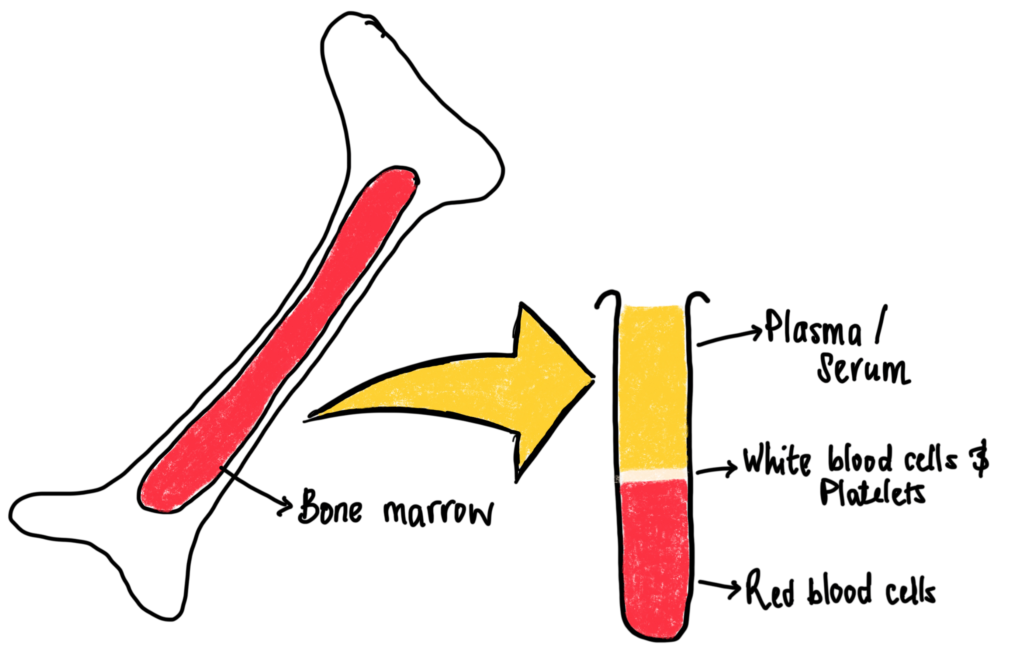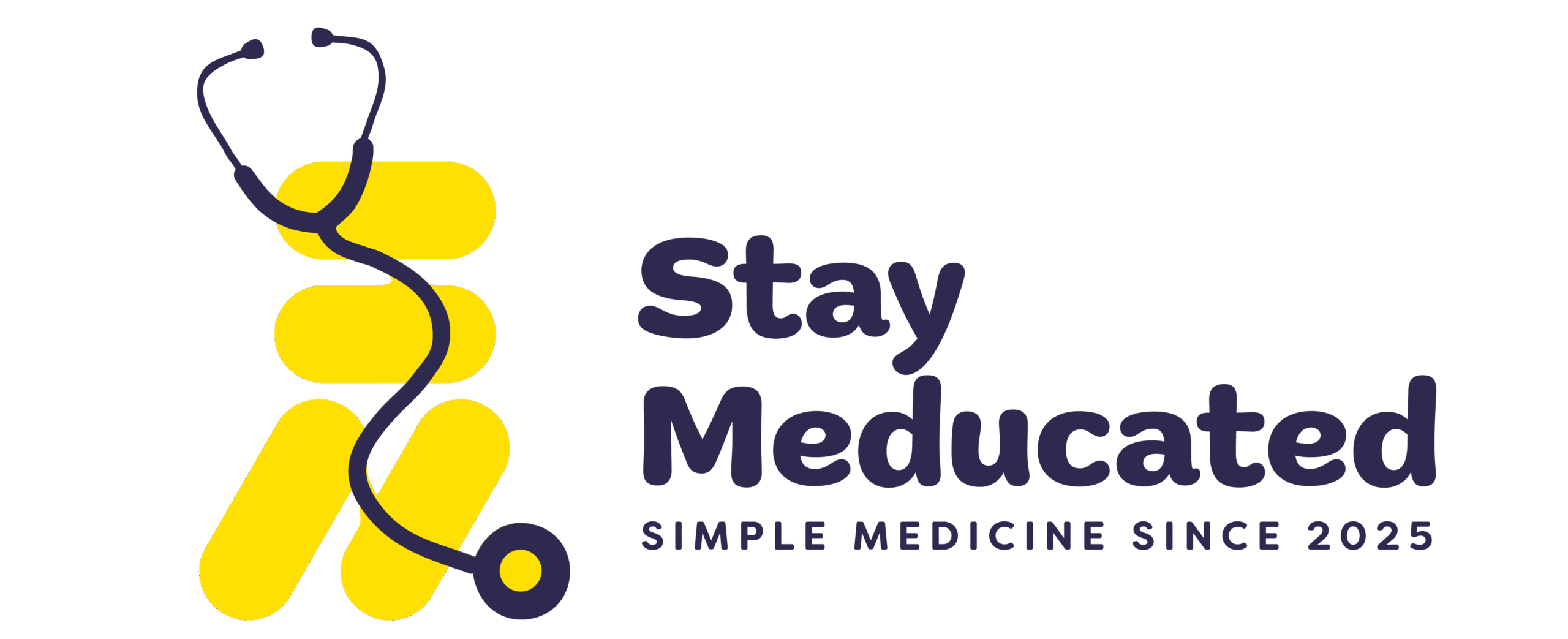I’ll be honest, this weeks topic is one that personally interests me, hence why I am writing about it. I know this topic might not be very relevant to you or anyone you know, but if understanding the human body interests you, then stick around, because Leukaemia is pretty interesting.
Leukaemia is a group of cancers that affect your blood and bone marrow, particularly your white blood cells. It’s not just one disease—there are several different types, and how they behave or how they’re treated depends on the specific type you have [1].
Let’s Start with the Basics: What’s in Your Blood?
Blood is much more than just the red liquid we see when we get a cut. It’s made up of cells and a liquid called plasma. Around 45% of your blood is made of cells, and the remaining 55% is plasma [5].

Figure 1 – Diagram of bone marrow and bloood separated into the three components. Created by Dr Mojibola Orefuja
The blood cells are made in the bone marrow, which is found in the centre of bones like your thigh bone. The three main types of blood cells are:
- Red blood cells – These carry oxygen around your body with the help of a protein called haemoglobin. They make up most of the blood’s cellular content, which is why blood appears red.
- White blood cells – These are your immune system’s defence team. They fight off infections and other invaders. There are several types of white blood cells, and they’re grouped in a few different ways. One common way is by their role in the immune response:
- Innate immune response – This is your body’s first line of defence. It’s fast and general. The white blood cells involved here are called myeloid cells, including types like granulocytes and monocytes [6].
- Adaptive immune response – This is slower to kick in but much more specific. It tailors its attack to the exact threat. The white blood cells here are lymphocytes, which make proteins that target specific invaders.
In leukaemia, the white blood cells don’t form properly. Instead, the bone marrow starts producing abnormal white blood cells that don’t work like they’re supposed to [1,2].
- Platelets – These are the cells that help your blood clot. They stop you from bleeding too much when you get injured.
Types of Leukaemia
There are many types of leukaemia, but they’re usually classified by:
- How quickly they develop (acute = fast, chronic = slow)
- Which blood cells are affected (lymphoid or myeloid cells)
- How the cancer cells look under a microscope
Here are the main types you might hear about:
Acute Lymphoblastic Leukaemia (ALL)
This is a fast-growing type of leukaemia that affects lymphocytes. Because the cells are made too quickly and don’t develop properly, they fill up the bone marrow and crowd out healthy cells. ALL mostly affects children [3,4].
Acute Myeloid Leukaemia (AML)
AML also grows quickly and needs urgent treatment. It affects myeloid cells, like granulocytes and monocytes. The immature cells don’t function properly, and they fill the bone marrow, blocking the production of healthy blood cells [6].
Chronic Lymphocytic Leukaemia (CLL)
This slow-growing cancer also affects lymphocytes, but symptoms may take years to appear. Unlike ALL, which progresses rapidly, people with CLL may not need immediate treatment [7].
Chronic Myeloid Leukaemia (CML)
CML affects myeloid cells and grows slowly. Like AML, it produces faulty cells, but its gradual progression often gives doctors more time to plan treatment [8].
Hairy Cell Leukaemia
A rare, slow-growing cancer that affects a type of lymphocyte called B cells. Under a microscope, the affected cells look like they have tiny hair-like projections—hence the name.
Other less common types include:
- Acute Promyelocytic Leukaemia
- Large Granular Lymphoblastic Leukaemia
- Childhood Leukaemia
- Chronic Myelomonocytic Leukaemia
Symptoms of Leukaemia
The symptoms of leukaemia mostly come from having too few healthy blood cells and too many abnormal ones.
When red blood cells are low:
- You may feel tired or weak
- You might look pale
When white blood cells are low:
- You’re more likely to get infections
- You may have fever
When platelets are low:
- You might bruise easily
- You could have nosebleeds or heavy periods
Other general symptoms:
- Weight loss
- Swollen glands
- Bloating or swelling in your abdomen due to enlarged organs
How Is Leukaemia Treated?
The treatment depends on the type and stage of leukaemia, as well as your overall health.
Acute Lymphoblastic Leukaemia (ALL) [10]
ALL is treated with chemotherapy in three phases:
- Remission Induction – The goal is to get rid of as many leukaemia cells as possible and bring the cancer into remission. This lasts around 4–8 weeks.
- Consolidation – Even if no leukaemia cells are visible, some may still be hiding. This phase aims to wipe those out over several months.
- Maintenance – Low-dose chemotherapy and steroids help prevent relapse.
Acute Myeloid Leukaemia (AML) [11]
AML treatment is intensive and usually split into two parts:
- Induction Therapy – High-dose chemotherapy kills off leukaemia cells. It’s usually given over 5–10 days, but recovery takes longer, often requiring a hospital stay.If cancer doesn’t go away after two rounds, it’s called refractory AML, and the treatment approach changes.
- Consolidation Therapy – This phase includes further chemo, and in some high-risk cases, a stem cell transplant is recommended to improve long-term outcomes.
Chronic Lymphocytic Leukaemia (CLL) [12,13]
CLL treatment usually starts only when symptoms appear. The first approach is called first-line treatment, and if that doesn’t work, doctors move to second-line treatment.
Common options include:
- Targeted therapy (e.g. cancer growth blockers)
- Immunotherapy
- Chemotherapy
The choice depends on your age, general health, genetic factors, and how well earlier treatments have worked.
Chronic Myeloid Leukaemia (CML) [14]
CML is usually treated with targeted therapy—especially drugs called Tyrosine Kinase Inhibitors. These stop abnormal proteins from helping cancer cells grow. For many people, this therapy keeps the cancer under control for years.
Conclusion
Leukaemia may sound like a single disease, but it actually refers to a whole group of cancers that behave very differently depending on the type. What they all have in common is that they disrupt how your blood cells are made, often leading to symptoms like fatigue, infections, and bleeding.
While some forms of leukaemia progress quickly and need urgent treatment, others grow slowly and might not require therapy right away. Treatment options have advanced significantly and are now tailored to the type of leukaemia and the individual’s needs—ranging from chemotherapy and targeted drugs to stem cell transplants.
References
- Blood Cancer UK. Understanding Leukaemia [Internet]. 2023 [cited 2025 May 20]. Available from: https://bloodcancer.org.uk/understanding-blood-cancer/leukaemia/
- Cancer Research UK. About leukaemia [Internet]. 2023 [cited 2025 May 20]. Available from: https://www.cancerresearchuk.org/about-cancer/leukaemia
- Wood BL. Acute Lymphoblastic Leukemia. In: StatPearls [Internet]. Treasure Island (FL): StatPearls Publishing; 2024 [cited 2025 May 20]. Available from: https://www.ncbi.nlm.nih.gov/books/NBK560490/
- Blood Cancer UK. Acute Lymphoblastic Leukaemia (ALL) [Internet]. 2023 [cited 2025 May 20]. Available from: https://bloodcancer.org.uk/understanding-blood-cancer/leukaemia/acute-lymphoblastic-leukaemia/
- American Society of Hematology. Blood Basics [Internet]. 2023 [cited 2025 May 20]. Available from: https://www.hematology.org/education/patients/blood-basics
- Cancer Research UK. About acute myeloid leukaemia (AML) [Internet]. 2023 [cited 2025 May 20]. Available from: https://www.cancerresearchuk.org/about-cancer/acute-myeloid-leukaemia-aml/about-acute-myeloid-leukaemia
- Cancer Research UK. About chronic lymphocytic leukaemia (CLL) [Internet]. 2023 [cited 2025 May 20]. Available from: https://www.cancerresearchuk.org/about-cancer/chronic-lymphocytic-leukaemia-cll/about
- Cancer Research UK. About chronic myeloid leukaemia (CML) [Internet]. 2023 [cited 2025 May 20]. Available from: https://www.cancerresearchuk.org/about-cancer/chronic-myeloid-leukaemia-cml/about
- Cancer Research UK. Acute lymphoblastic leukaemia (ALL) statistics [Internet]. 2023 [cited 2025 May 20]. Available from: https://www.cancerresearchuk.org/health-professional/cancer-statistics/statistics-by-cancer-type/leukaemia-all#heading-Two
- Blood Cancer UK. ALL active treatment and side effects [Internet]. 2023 [cited 2025 May 20]. Available from: https://bloodcancer.org.uk/understanding-blood-cancer/leukaemia/acute-lymphoblastic-leukaemia/all-treatments-side-effects/all-active-treatment/
- Blood Cancer UK. AML intensive treatment [Internet]. 2023 [cited 2025 May 20]. Available from: https://bloodcancer.org.uk/understanding-blood-cancer/leukaemia/acute-myeloid-leukaemia/aml-treatment/intensive/
- Blood Cancer UK. CLL first and second-line treatments explained [Internet]. 2023 [cited 2025 May 20]. Available from: https://bloodcancer.org.uk/understanding-blood-cancer/leukaemia/chronic-lymphocytic-leukaemia-cll/cll-treatment-side-effects/first-second-line-treatments-explained/
- Blood Cancer UK. CLL treatment options and side effects [Internet]. 2023 [cited 2025 May 20]. Available from: https://bloodcancer.org.uk/understanding-blood-cancer/leukaemia/chronic-lymphocytic-leukaemia-cll/cll-treatment-side-effects/cll-treatment-options/
- Blood Cancer UK. Tyrosine kinase inhibitors in CML treatment [Internet]. 2023 [cited 2025 May 20]. Available from: https://bloodcancer.org.uk/understanding-blood-cancer/leukaemia/chronic-myeloid-leukaemia-cml/cml-treatment-side-effects/tyrosine-kinase-inhibitors/
